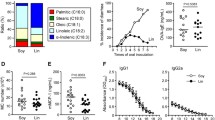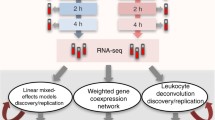Abstract
Acute anaphylaxis caused by food allergy is a potentially life-threatening allergic reaction that results in thousands of hospitalizations in North America every year. There are currently no effective means of treatment for anaphylaxis beyond the administration of epinephrine which is only given after a reaction has already started. Furthermore, knowledge regarding the underlying physico-chemical basis of anaphylaxis is largely incomplete. Arguably, the study of anaphylaxis by comprehensive metabolomics offers a unique opportunity to study this phenomenon due to its ability to provide a snap-shot of the chemical state of a subject experiencing anaphylaxis encompassing both endogenous and exogenous factors including dietary and environmental effects. In this study, we sought to apply a comprehensive metabolomics approach using liquid chromatography–mass spectrometry to a murine model of peanut-induced anaphylaxis. The results of this study revealed that the metabolomic profiles of mice experiencing peanut-induced anaphylaxis followed a distinct pattern that mirrors the time-stage of anaphylaxis being experienced. Direct comparison of anaphylactic mice to time-matched control mice showed that the metabolomic profiles changed considerably as the anaphylactic reaction progressed. This comparison also revealed changes in both known biomarkers of anaphylaxis such as histamine and methylhistamine as well as a suite of metabolites chemically similar to known anaphylaxis mediators but whose biological functions are not well understood. These metabolites include a number of phospholipids such as a variety of phosphatidylcholines and lyso-phosphatidylcholines that may be of interest for further investigation regarding their potential as anaphylaxis mediators or chemical precursors to mediators.




Similar content being viewed by others
Abbreviations
- CT:
-
Cholera toxin
- GC–MS:
-
Gas chromatography–mass spectometry
- i.p.:
-
Intraperitoneal
- LC–ESI-TOF-MS:
-
Liquid chromatography–electrospray ionization-time-of-flight-mass spectrometry
- OPLS-DA:
-
Orthogonal partial least squares-discriminate analysis
- PIA:
-
Peanut-induced anaphylaxis
- PAF:
-
Platelet activating factor
References
Abe, M., Tokunaga, T., Yamada, K., & Furukawa, T. (1988). Gamma-aminobutyric acid and taurine antagonize the central effects of angiotensin II and renin on the intake of water and salt, and on blood pressure in rats. Neuropharmacology, 27(3), 309–318.
Amin, K. (2012). The role of mast cells in allergic inflammation. Respiratory Medicine, 106(1), 9–14.
Arias, K., Baig, M., Colangelo, M., Chu, D., Walker, T., Goncharova, S., … Jordana, M. (2009). Concurrent blockade of platelet-activating factor and histamine prevents life-threatening peanut-induced anaphylactic reactions. The Journal of Allergy and Clinical Immunology, 124(2), 307–314, 314.e1–2.
Arias, K., Chu, D. K., Flader, K., Botelho, F., Walker, T., Arias, N., … Jordana, M. (2011). Distinct immune effector pathways contribute to the full expression of peanut-induced anaphylactic reactions in mice. The Journal of Allergy and Clinical Immunology, 127(6), 1552–1561.e1.
Berni Canani, R., Di Costanzo, M., & Troncone, R. (2011). The optimal diagnostic workup for children with suspected food allergy. Nutrition, 27(10), 983–987.
Brown, F., McKinnon, D., & Chu, K. (2001). Emergency department anaphylaxis: A review of 142 patients in a single year. The Journal of Allergy and Clinical Immunology, 108(5), 861–866.
Bruce, S. J., Tavazzi, I., Parisod, V., Rezzi, S., Kochhar, S., & Guy, P. (2009). Investigation of human blood plasma sample preparation for performing metabolomics using ultrahigh performance liquid chromatography/mass spectrometry. Analytical Chemistry, 81(9), 3285–3296.
Dunn, W. B., Broadhurst, D., Begley, P., Zelena, E., Francis-McIntyre, S., Anderson, N., … Goodacre, R. (2011). Procedures for large-scale metabolic profiling of serum and plasma using gas chromatography and liquid chromatography coupled to mass spectrometry. Nature Protocols, 6(7), 1060–1083.
Finkelman, F. D. (2007). Anaphylaxis: Lessons from mouse models. The Journal of Allergy and Clinical Immunology, 120(3), 506–515. quiz 516–7.
Grossmann, M., Dobrev, D., Himmel, H. M., Ravens, U., & Kirch, W. (2001). Ascorbic acid-induced modulation of venous tone in humans. Hypertension, 37(3), 949–954.
Hanahan, D. J. (1986). Platelet activating factor. Annual Review of Biochemistry, 55(1), 483–509.
Hu, X., Wu, G.-P., Zhang, M.-H., Pan, S.-Q., Wang, R.-R., Ouyang, J.-H., … Liu, D.-B. (2012). GC–MS-based metabolic profiling reveals metabolic changes in anaphylaxis animal models. Analytical and Bioanalytical Chemistry, 404(3), 887–893.
Johnson, C. H., & Gonzalez, F. J. (2012). Challenges and opportunities of metabolomics. Journal of Cellular Physiology, 227(8), 2975–2981.
Laidlaw, T. M., & Boyce, J. A. (2012). Cysteinyl leukotriene receptors, old and new; implications for asthma. Clinical and Experimental Allergy, 42(9), 1313–1320.
McNiven, E. M. S., German, J. B., & Slupsky, C. M. (2011). Analytical metabolomics: Nutritional opportunities for personalized health. The Journal of Nutritional Biochemistry, 22(11), 995–1002.
Mehl, A., Wahn, U., & Niggemann, B. (2005). Anaphylactic reactions in children—a questionnaire-based survey in Germany. Allergy, 60(11), 1440–1445.
Patti, G. J., Yanes, O., & Siuzdak, G. (2012). Innovation: Metabolomics: The apogee of the omics trilogy. Nature Reviews Molecular Cell Biology, 13(4), 263–269.
Sampson, H. A. (2003). Anaphylaxis and emergency treatment. Pediatrics, 111(6 Pt 3), 1601–1608.
Smit, D. V., Cameron, P. A., & Rainer, T. H. (2005). Anaphylaxis presentations to an emergency department in Hong Kong: Incidence and predictors of biphasic reactions. The Journal of Emergency Medicine, 28(4), 381–388.
Strait, R. T., Morris, S. C., Yang, M., Qu, X.-W., & Finkelman, F. D. (2002). Pathways of anaphylaxis in the mouse. Journal of Allergy and Clinical Immunology, 109(4), 658–668.
Sumner, L. W., Amberg, A., Barrett, D., Beale, M. H., Beger, R., Daykin, C. A., … Viant, M. R. (2007). Proposed minimum reporting standards for chemical analysis. Metabolomics, 3(3), 211–21.
Sun, J., Arias, K., Alvarez, D., Fattouh, R., Walker, T., Goncharova, S., … Jordana, M. (2007). Impact of CD40 ligand, B cells, and mast cells in peanut-induced anaphylactic responses. Journal of Immunology, 179(10), 6696–703.
Weller, P. F., & Dvorak, A. M. (1994). Lipid bodies: Intracellular sites for eicosanoid formation. The Journal of Allergy and Clinical Immunology, 94(6 Pt 2), 1151–1156.
Wishart, D. S., Jewison, T., Guo, A. C., Wilson, M., Knox, C., Liu, Y., … Scalbert, A. (2013). HMDB 3.0–The Human Metabolome Database in 2013. Nucleic acids research, 41(Database issue), D801–807.
Yocum, M. W., Butterfield, J. H., Klein, J. S., Gerald, W., Schroeder, D. R., & Silverstein, M. D. (1987). Food and drug reactions and anaphylaxis Epidemiology of anaphylaxis in Olmsted County?: A population-based study, 452–456.
Zhang, G.-F., Sadhukhan, S., Tochtrop, G. P., & Brunengraber, H. (2011). Metabolomics, pathway regulation, and pathway discovery. The Journal of Biological Chemistry, 286(27), 23631–23635.
Acknowledgments
This work was carried out with the support and funding of Anaphylaxis Canada and the National Science and Engineering Research Council of Canada. Technical assistance was provided by Tina Walker, Susanna Goncharova, and Leen Naji.
Conflict of interest
The authors declare no conflicts of interest.
Author information
Authors and Affiliations
Corresponding author
Additional information
This work is dedicated to the memory of Brian E. McCarry. Chalcraft and Kong contributed equally to this work.
Electronic supplementary material
Below is the link to the electronic supplementary material.
Rights and permissions
About this article
Cite this article
Chalcraft, K.R., Kong, J., Waserman, S. et al. Comprehensive metabolomic analysis of peanut-induced anaphylaxis in a murine model. Metabolomics 10, 452–460 (2014). https://doi.org/10.1007/s11306-013-0589-7
Received:
Accepted:
Published:
Issue Date:
DOI: https://doi.org/10.1007/s11306-013-0589-7




